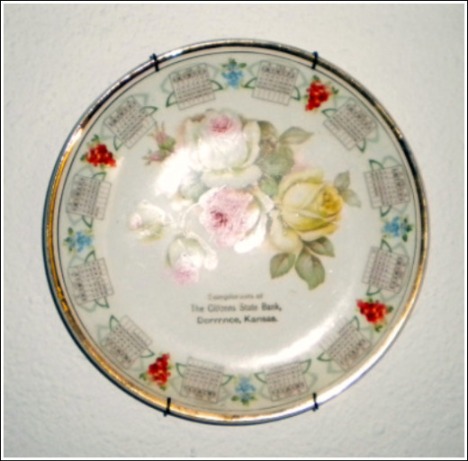
Calendar Plate--The Citizens State Bank, Dorrance, Kansas from 1911--I probably admired this plate so many times that my grandma finally gave it to me. It's one of my treasures.
For a kid, my grandma’s house wasn’t the most fun place to visit, especially if you went there almost every day. It was pleasant enough on summertime evenings, when the grown-ups sat on the front porch and we kids sat on the “stoop” or ran down into the ravine (which wasn’t really a ravine, but a low place where the water ran when it rained) to catch lightning bugs.
But other times, when you had to be inside, there wasn’t much to do. Grandma was quiet and serious, and kids were expected to behave. There were no toys to play with at Grandma’s. Thinking back on it, I wonder why the folks never left a few of our toys there for us to have something to do when we went there, but they didn’t.
I say there were no toys to play with at Grandma’s, but there was –“the wheel”. The wheel was a miniature tire, about 6 inches in diameter, and had probably been a promotional give-away from one of the local filling stations, most likely originally with a glass ashtray in the middle. So when a very small child came to Grandma’s, she dug out “the wheel” for them to play with. And even when you got older, the wheel still had some fascination when it was gotten out for a younger relative.
But when you got older, there were other things at Grandma’s house to get your interest, if you had sense enough to keep your adolescent mind focused.
Grandma’s house had a parlor, and the parlor, indeed, was treated as that, a special room. In fact, it was on the other side of the house from the front room (living room) with a bedroom in between. It was not often that Grandma would “open up” the parlor. Opening up the parlor meant pulling back heavy, velvet, dark burgundy drapes that closed off the bedroom from the parlor. In the spring and summer, in order to help the air circulate, it also meant opening the parlor door, which was a second entrance to the house.
There were some odd pieces of furniture in the parlor: a library table with photos of grandkids on it, and a leather and wooden sofa, which was the hardest thing I’ve ever sat on. The biggest attraction in the parlor was the secretary, one of those old-timey pieces with a tall cabinet with a glass door on one side and a pull-down writing desk on the other side. Inside the cabinet, there were various knick-knacks and pieces of glassware, but the real gold mine was the two velvet-covered picture albums that held family photos, some so old they were tin-types.
I remember sitting with my mom looking at them. Grandma never had the desire to sit and look through a whole book, but she’d help to identify unknown faces. After Grandma’s death, some of the relatives got the albums and I have never seen them again. Fortunately, I do have a lot of old family photos given to me by my mom or other relatives.
Maybe I’ve got “the cart before the horse” in my memory lane narrative, but a discovery I made last night has got me thinking about those old photos.
I’ve mentioned my hometown–Dorrance, Kansas before. You can take the kid out of the country, but you can’t take the country out of the kid. Well, that’s me, not a kid, except at heart, by any long shot these days, and I’ve lived in one of the biggest cities in the U.S. now for almost half my life. But Dorrance will always be a part of me, even as I get older and Dorrance’s population dwindles even smaller and smaller.
Dorrance is very lucky, though, and, unlike many small towns, has a way of keeping its history, thanks in part to a young budding photographer, who lived there a hundred years ago. His name was Leslie Halbe, and for a period of about four years–1908 to 1912, he took pictures of the people in and around Dorrance, both in portraits and in daily activities. This was done with one of those old cameras that used glass negatives. Although Leslie moved away from Dorrance in 1912, by luck and maybe some foresight, most of these negatives finally ended up in the Kansas State Historical Society in Topeka. There have been different exhibitions of Halbe’s work through the years.
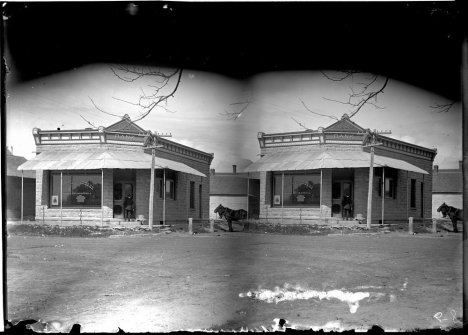
The Citizens State Bank, Dorrance, Kansas, May 26, 1909, by Leslie Halbe. This building is still standing on Main Street in Dorrance. It was the office of the Dorrance Telephone Company when I was a little kid and more recently was a barber shop. Notice how the negatives of the old photos had two images. This is the bank my plate came from.
Sometime back, I discovered that part of Halbe’s photos were available on Kansas Memory (click in the sidebar or below). Then last night, I found that they now have all of the 1500+ photos online. I still haven’t looked at them all. But I will.
I know that some of Leslie Halbe’s photos had to have been in those album’s kept in Grandma’s secretary. I remember also that one of the “Halbe boys” had been one of my mother’s elementary school teachers. One of the articles said Leslie Halbe’s parents ran a candy shop. If what I remember is correct, it was the drug store, which in the early days might have been called a confectionary. The drug store closed in Dorrance when I was in grade school, but not only did they sell over the counter drugs and bits of what a Walgreen’s might have today, they had a soda fountain, where you could buy ice cream, soft drinks, and sandwiches.
Halbe’s photos leave a record of the people and life of not only my hometown, but really of small town America on the Great Plains during the early 1900s.
- If you’re interested in learning more about Leslie W. (Winfield) Halbe and his photos, read here and here.
- If you want to access the Halbe Collection photos and Kansas Memory, go here.
These are some of my favorite photos from the collection, so far:

Dorrance Telephone Operators and Office, Nov. 6, 1909. This photo is probably one of the most popular from the Halbe Collection.
Filed under: Geography, It's What I Like, Maps, Geography, and Places, Politics and Gay Topics, Remembrances | Tagged: calendar plate, Citizens State Bank, dorrance, gay, Grandma, Great Plains, harvest, historyical photos, Kansas, Kansas history, lesbian, Leslie W. Halbe, lgbt, photography, U.S. History |



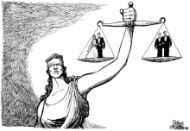
 http://jointheimpact.com
http://jointheimpact.com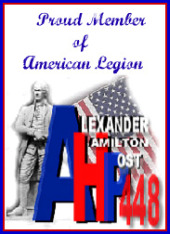
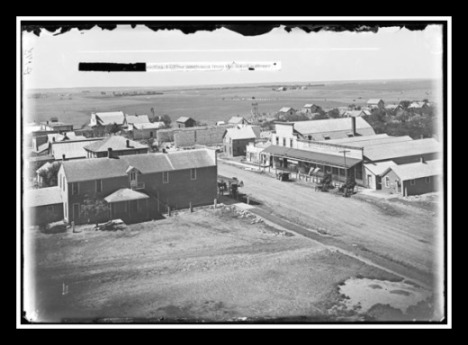




[…] https://triptotheouthouse.wordpress.com/2009/08/09/grandmas-house-and-a-one-of-a-kind-photo-collectio… […]